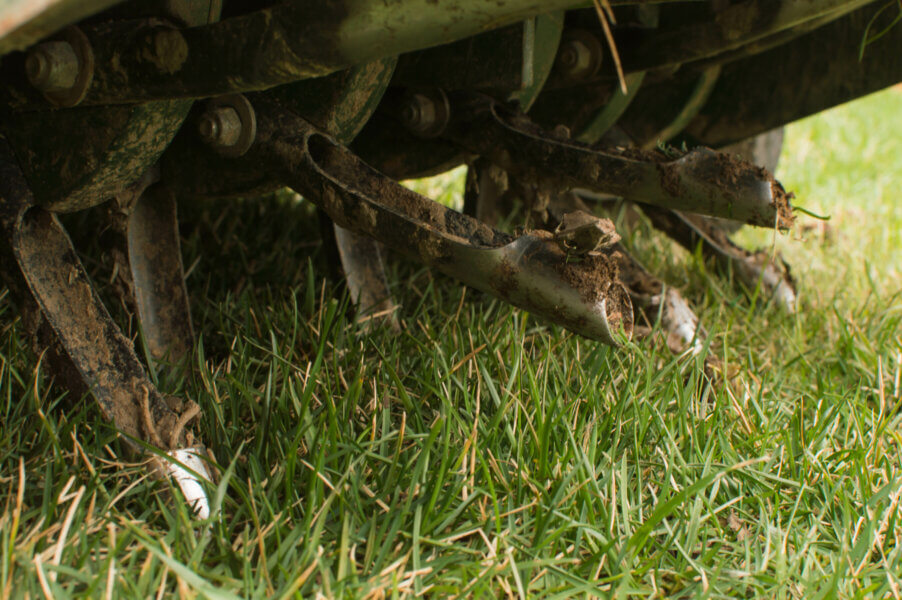
The Ultimate Guide to Lawn Aeration: Why, When, and How
Having a high-quality, stunning lawn takes a lot of time and effort to achieve and maintain. However, if you’re serious about keeping your grass green and lush year after year, it’s worth doing everything right. While mowing, watering, and fertilizing are all necessary, you can’t forget other aspects of lawn maintenance, like aeration. Lawn aeration helps your grass grow better and allows water and fertilizer to reach the roots more easily. Here’s everything you need to know about aeration and why it matters.
What is Lawn Aeration?
Lawn aeration is the process of putting holes in the soil to reduce the effects of compaction. Soil compaction happens constantly, especially as you use your lawn throughout the year. Unfortunately, as the dirt compresses, it makes it harder for water and nutrients to move through the root system. Aeration helps reverse this issue, so your grass can thrive.
Why is Lawn Aeration Service Important?
The primary reason to aerate your lawn is to help essential nutrients move through the soil. However, there are some tangible, noticeable benefits of this process, including:
- Better Drainage – When it rains, you want the water to drain through your lawn as efficiently as possible. If it pools in various spots, the excess water could kill off the grass. Aeration helps water move more quickly through the dirt, so pooling doesn’t happen.
- Stronger Roots – Healthy grass starts at the roots. If you’re not helping the roots receive and retain the nutrients necessary for a healthy lawn, they’ll begin to die off. Also, stronger roots help keep your soil more stable and reduce erosion.
- Fewer Patches – Your lawn should have a uniform green color to it. Patches can occur when some sections of the grass can’t get water or nutrients due to either thatch or soil compaction. While there are other reasons for patchy grass, aeration can help prevent the problem.
How to Aerate Your Lawn Properly
There are a few ways to aerate your lawn, but before we discuss the best option, here are some methods to avoid:
- Spike Aeration – You may have seen spikes you can wear on your shoes or devices that allow you to poke holes in your grass. Unfortunately, these spikes don’t penetrate enough to have much effect.
- Blade Aeration – Instead of spikes, these aerators use blades to cut lines in the lawn and the dirt. They don’t leave much of a mess, but the slices are too thin to aerate correctly.
The best way to aerate your lawn is with a core aerator. You can use a manual or electronic model, although we always recommend electric. Unless you have a tiny yard, aerating the grass manually is time-consuming and exhausting. Automated machines can do the work in a fraction of the time and achieve better results.
Coring involves punching a hole in the grass and removing a section of soil. Removing the soil is essential for proper aeration, as the spaces allow water and air to reach the roots. Spiked holes can fill in too quickly, negating many of the positive effects.
Coring can leave a bit of a mess on your lawn, but the results are worth it. Also, you can adjust the depth and diameter of the cores to help reduce the amount of loose soil on your grass afterward.
Other aspects of lawn aeration service to consider include:
- Avoid Sprinklers – Make sure to mark your sprinklers so you avoid them (and any costly repairs).
- Aerate Soft Ground – The best time to aerate is after it’s rained (not immediately, though) when the ground is soft. The machine won’t have to work as hard, so you can finish much faster.
- Don’t Forget to Remove the Cores – Wait for the soil to dry out, then rake it apart. You don’t have to collect the dirt for disposal, but you need to ensure it won’t suffocate any patches of grass.
How Often Should You Aerate Your Lawn or grass?
Ideally, you only have to aerate your lawn once per year. The best time is late summer or early fall. Chances are you used the lawn a lot during the summer, so soil compaction is at its highest. If you wait too long, colder temperatures could damage the roots after aeration. Overall, early September is often the best time of year.
Get the Best Sod From Duda Sod
If your lawn is struggling to look its best, it may be time to upgrade to pre-grown sod. Duda Sod is one of the best sod farms in Florida, and we have many grass varieties to suit your preferences. It’s much easier to maintain high-quality grass than it is to play catch-up with a subpar lawn. Let Duda Sod help you achieve your landscaping dreams.